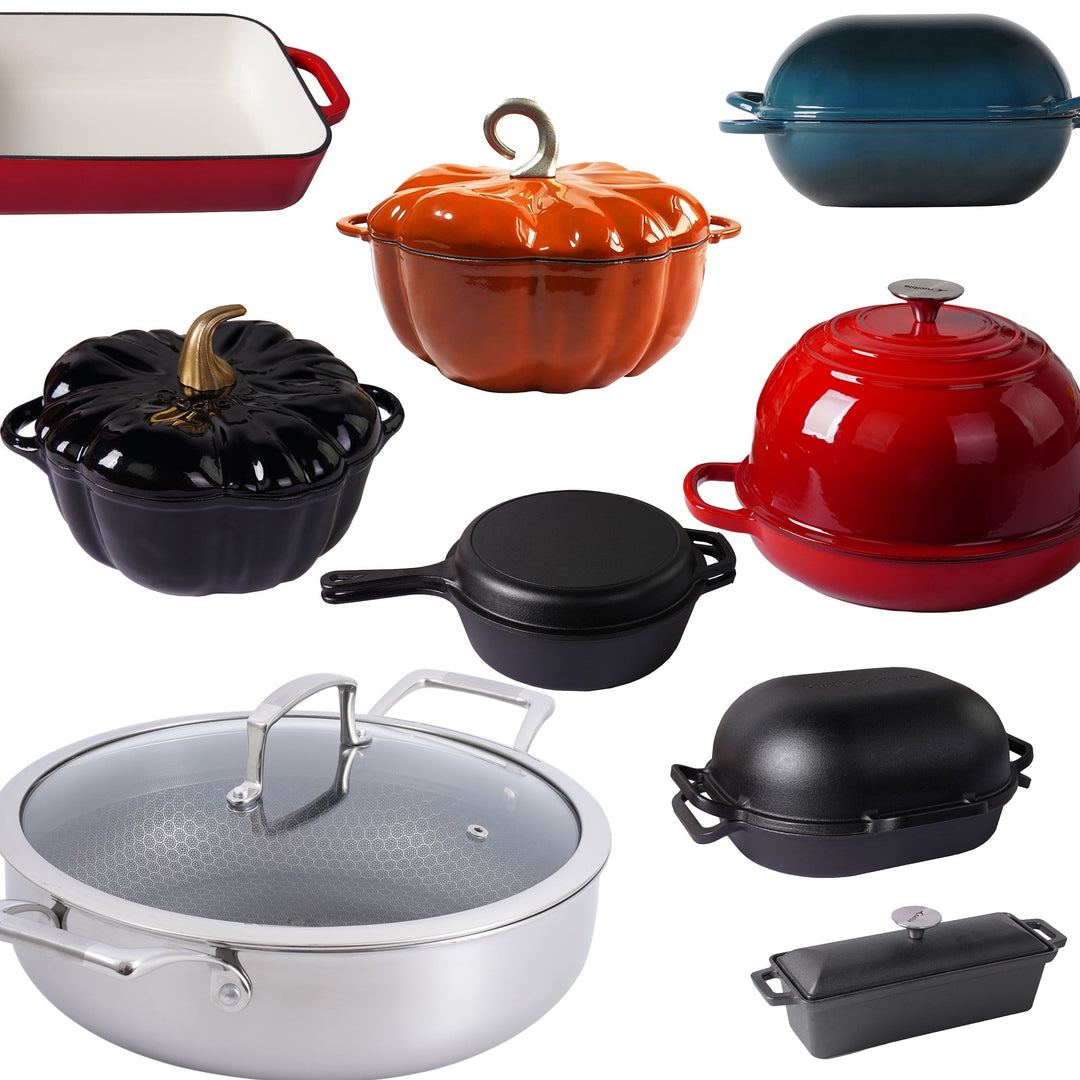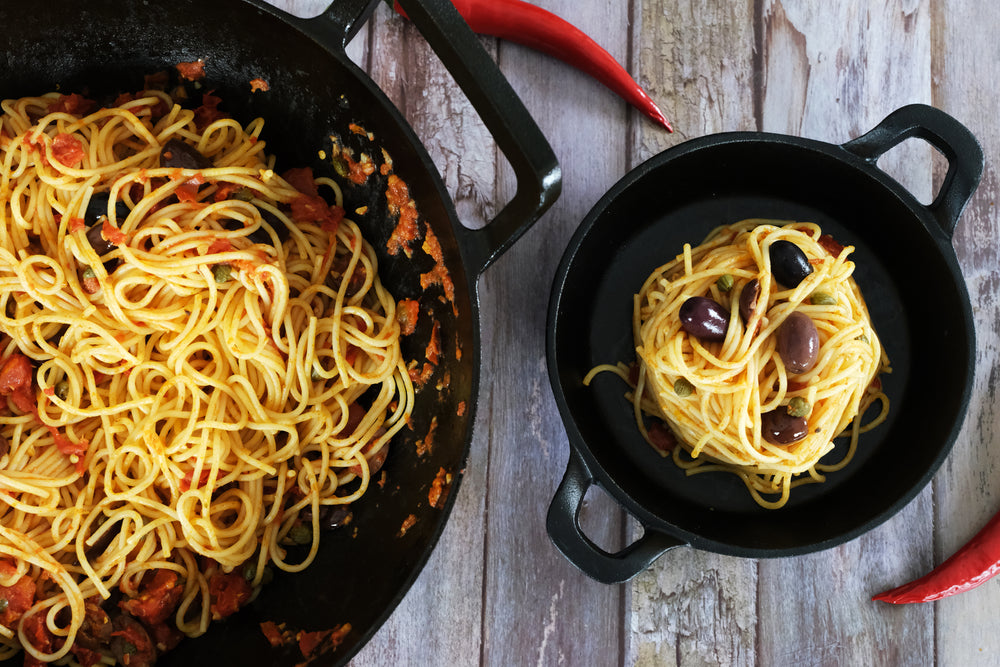Наука за Прокаливанием чугунной посуды: мифы, методы и уход

Для тех, кто любит готовить, чугунная посуда является любимой на кухне благодаря своей прочности, универсальности и насыщенному вкусу, который она может добавить блюдам. Однако одна тема, которая часто вызывает споры, — это как правильно прокаливать и ухаживать за этими классическими сковородами. От противоречивых советов по маслам до различных методов нагрева существует множество заблуждений о прокаливании чугуна. В этом посте мы погрузимся в науку прокаливания, развеем распространённые мифы и предоставим надежные шаги, чтобы ваша чугунная посуда служила вам наилучшим образом долгие годы.
Что означает Прокаливание чугунной посуды?
«Прокаливание» чугуна означает создание защитного слоя полимеризованного масла, который сцепляется с поверхностью сковороды. Этот слой наращивается со временем и выполняет несколько важных функций:
- Антипригарная поверхность: Правильное прокаливание формирует гладкий, антипригарный слой, позволяя легко переворачивать блины, обжаривать стейки и тушить овощи без прилипания.
- Защита от ржавчины: Чугун подвержен ржавчине при контакте с влагой. Прокаливание служит барьером, защищая чугун от воды и окисления.
- Развитие вкуса: Прокаливание со временем придаёт уникальный вкусовой профиль, поэтому многие повара ценят хорошо прокалённые сковороды.
Научная основа Прокаливания
Прокаливание — это процесс, называемый полимеризацией, при котором масло нагревается выше точки дымления, что приводит к его разложению и сцеплению с поверхностью чугуна. При этом жирные кислоты масла проходят химическую реакцию, образуя гладкий, твёрдый слой. Главное — постепенно наращивать этот слой, чтобы он равномерно прилипал и формировал прочное, антипригарное покрытие.
Идеальные масла для прокаливания содержат высокую концентрацию ненасыщенных жиров, которые с большей вероятностью полимеризуются. Некоторые из лучших вариантов включают:
- Льняное масло
- Виноградное масло
- Подсолнечное масло
- Рапсовое масло
Эти масла быстро разлагаются при высоких температурах, обеспечивая правильное сцепление с поверхностью чугуна.
Развенчание распространённых мифов о Прокаливании
Миф 1: Следует использовать только один вид масла
Хотя льняное масло популярно благодаря высокой способности к полимеризации, не обязательно использовать только один вид масла. Главное — использовать масла с высокой температурой дымления, но не бойтесь экспериментировать с виноградным, рапсовым или подсолнечным маслом для прокаливания. Каждое масло имеет свои преимущества и может использоваться взаимозаменяемо при условии поддержания постоянной температуры и времени.
Миф 2: Блестящая сковорода — признак хорошо прокалённой сковороды
Не обязательно. Правильно прокалённая сковорода будет иметь матовое, чёрное покрытие. Блестящая поверхность может указывать на то, что прокаливание не закрепилось должным образом или сковорода была перекормлена маслом. Цель — получить гладкий, равномерный слой, который при прикосновении ощущается почти как мягкая патина.
Миф 3: Мыло уничтожит ваше Прокаливание
Существует распространённое мнение, что использование мыла на чугунной сковороде удалит прокаливание, но это не так. Современные моющие средства не так агрессивны, как раньше, и не удалят хорошо закреплённый слой прокаливания. Однако избегайте использования абразивных губок или стальной ваты, так как они могут поцарапать поверхность.
Пошаговое руководство по Прокаливанию вашей чугунной посуды
Готовы уделить вашей чугунной посуде немного заботы? Вот проверенный метод прокаливания вашей сковороды:
-
Тщательно очистите сковороду: Начните с мытья сковороды теплой мыльной водой. Используйте щетку или неабразивную губку, чтобы удалить остатки пищи. Полностью высушите с помощью безворсовой ткани или бумажного полотенца.
-
Разогрейте духовку: Разогрейте духовку до 450°F (230°C). Поставьте сковороду в духовку примерно на 10 минут, чтобы она полностью высохла и прогрелась.
-
Нанесите тонкий слой масла: С помощью бумажного полотенца или ткани равномерно нанесите небольшое количество выбранного масла на внутреннюю и внешнюю поверхности сковороды. Затем протрите чистым полотенцем, чтобы убрать излишки. Сковорода должна выглядеть почти сухой после этого.
-
Запеките сковороду: Поставьте сковороду вверх дном на среднюю решетку духовки. На нижнюю решетку положите кусок алюминиевой фольги или противень, чтобы поймать капли. Запекайте сковороду 1 час при 450°F.
-
Остудите и повторите: Выключите духовку и дайте сковороде остыть внутри. Для лучших результатов повторите этот процесс 2-3 раза, чтобы создать прочный слой прокаливания.
Уход за прокаливанием
Прокаливание — это не одноразовый процесс. Со временем приготовление кислых продуктов, использование агрессивных методов очистки или пренебрежение регулярным смазыванием могут изнашивать слой. Вот как поддерживать ваш чугун в отличном состоянии:
- После каждого использования: Ополосните сковороду теплой водой и используйте неабразивную губку. Если есть стойкие остатки, немного прокипятите воду в сковороде, чтобы их размягчить.
- Сразу высушите: Всегда тщательно сушите сковороду после мытья. Поставьте её на плиту на слабый огонь, чтобы испарить оставшуюся влагу.
- Легко смажьте маслом: После каждого использования нанесите очень тонкий слой масла на внутреннюю поверхность сковороды, пока она еще теплая. Это помогает поддерживать прокаливание и предотвращает ржавчину.
Устранение неполадок: Что делать, если моя сковорода заржавела?
Ржавчина может появиться, если чугун долго остается влажным или слой прокаливания изнашивается. Если вы заметили ржавые пятна, не волнуйтесь — это исправимо!
- Потрите ржавое место стальной ватой, пока ржавчина не исчезнет.
- Тщательно вымойте сковороду с мылом и водой.
- Полностью высушите и повторно прокалите, следуя приведённым выше шагам.
Заключительные мысли
С небольшим уходом ваша чугунная посуда может стать одним из самых надежных инструментов на вашей кухне. Понимание науки, стоящей за прокаливанием, помогает развеять мифы о процессе и гарантирует правильный уход за сковородой. Помните, главное — постепенно наращивать прокаливание, регулярно поддерживать его и наслаждаться насыщенными, ароматными блюдами, которые может создать только чугун.
Если помнить эти советы, у вас будет сковорода, которая работает как профессиональная — и при этом отлично выглядит! Приятного приготовления!
















Оставить комментарий